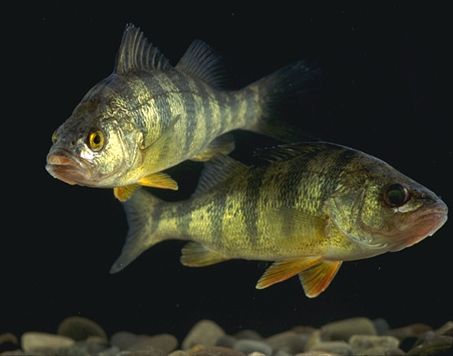Michigan Yellow Perch
Illustration by Joseph R. Tomelleri ©
Perca flavescens – scientific nameIDENTIFICATION:
(Native Fish) Two dorsal fins separated into a spiny and soft-rayed portion, yellow sides, seven blackish bars on the sides, no canine teeth.
FISHING:
Yellow perch have the distinction of being the most frequently caught game fish in Michigan perch travel in schools, generally preferring relatively shallow waters near shore. They are rarely taken from waters more than 30 feet deep, although in spring and fall they inhabit shallower areas than they do in the heat of the summer. They tend to travel shoreward each morning and evening to feed, while during the spring and fall they appear to feed throughout the day. At night they rest on the bottom and refrain from feeding. Unlike many Great Lakes fish species, perch remain active all winter long under the ice in both shallow and deeper water; hence they provide ice anglers with lots of opportunities. They inhabit all the Great Lakes, with greatest Michigan concentrations in Lake Erie, Lake St. Clair, Saginaw Bay, the eastern end of the U.P. and southern Michigan.
DIET:
Adult perch dine primarily on immature insects, larger invertebrates, (crayfish) and the eggs and young of other fish, which they take both from open water and from the bottom. In turn, bass, walleye and northern pike all prey on perch.
LIFE HISTORY:
Perch average adult length is four to 10 inches, with a weight of four to 10 ounces. Male perch reach sexual maturity at about three years of age, females at four. Perch spawn in the spring, laying eggs in gelatinous strings over dense vegetation, roots, and fallen trees in the shallows. These spawning grounds provide some of the best perch fishing available.
BACKGROUND INFORMATION:
Perch are prolific breeders, but growth and ultimate size depend on population density and habitat productivity. Crowding results in stunted offspring that may never exceed a length of six inches; thus, a controlled harvest program can benefit both the angler and the fish themselves. When given the choice, perch prefer a water temperature of 66 to 70 degrees F and often they follow the 68 degree F water temperature levels during their seasonal movements.



